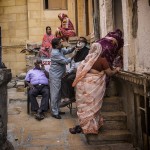Benares, riva dell’anima
Benares is the holiest city of Hinduism. Today known as Varanasi, owes its name to the rivers Varuna, which flows to the north, and Aces flowing south.
In 1033 the city was conquered by Mahmud of Ghazni that destroyed it. In 1194 it was sacked again by the armies of Ghurid army, until you get to the domain of Ala-ud-din Khilji of Delhi which destroyed the temples surviving to replace them with a large number of mosques. The Islamic influence remained until the eighteenth century when the name of the city was, for a short time, changed in Mohammadabad.
Every year millions of pilgrims visit the city, offering a unique opportunity to breathe and live millennial rites.
On the west bank of the river Ganges, buildings and dark alleys overlap disordered along the Ghats, the famous steps leading down along the sacred river.
Among the many steps the Assi Ghat is the most important. Located at the point where the Assi river flows into the Gange is considered one of the most sacred, is in fact identified as one of five sites where pilgrims should bathe in the day, to make effective their prayers. At dawn, in a dreamlike atmosphere the Ghats slowly begin to come alive.
Hundreds of boats carry pilgrims and inhabitants from one Ghat to another. When the sun begins to radiate its heat everything takes shape, the reflection in the river clearly outlines the beginning of a new day.
Along the stairways, priests, soothsayers and astrologers impart mantra to believers to ensure their salvation.
Within minutes, the Ghats swarm with people. A flow of life and death where there is no separation.
The shore is populated by hundreds of Sadhus who meditate practicing yoga, or live their spirituality.
Some plunge in the Gange, others lathers and rinse like they would do at home, and those who may be absorbed, sitting in meditation on the steps. Others engaged in the laundry laughing and playing around.
All strictly on the western shore, Varanasi is sacred only on this side. Over the other side there is only desert.
Along the Manikarnika Ghat workers prepare the wood for the pyres where burning the bodies of the dead. Fire purifies, and this is the fate that touches every Hindu.
With some exceptions; children do not need to be cremated (because they are already clean), those who die from the bite of a snake, pregnant women, animals and Sadhus.
A succession of souls where everyone has a place and live their lives.
When the twilight colors the sky pink, space is left to the fire ceremony, the Ganga Aarti.
The celebration takes place on the main Ghat where the Brahmins perform an elaborate Puja (ritual offering) that has as it’s essential component fire.
Thousands of people take the old and imposing staircases to attend the ceremony.
The candles offered by the faithful embrace the silence of the sunset, the life is gone…


















































